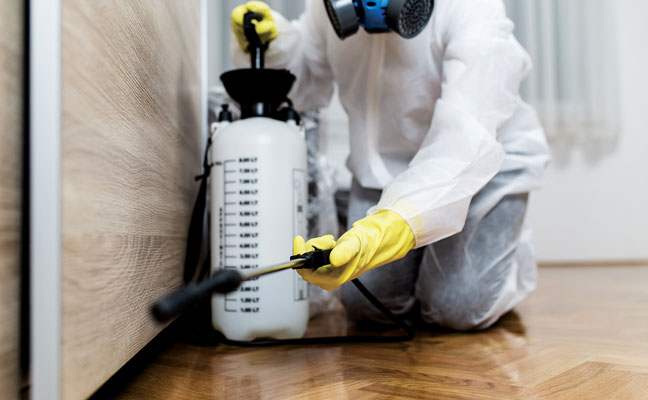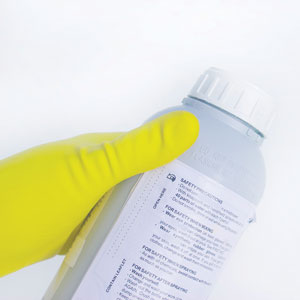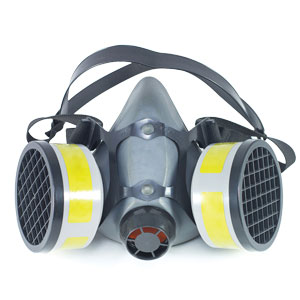
What personal protective equipment is required for each product? It doesn’t count if it’s left in the vehicle. Photo: Group4 Studio/E+/Getty Images
Once upon a time, pesticide label wording was loose and general. For example:
- “Apply liberally and repeat applications as often as necessary.”
- “Apply for all crawling and flying insects.”
By contrast, today’s pesticide labels include statements about protecting pollinators and endangered species, and avoiding areas where standing water exists or may occur after it rains.
Some labels now state “Before applying any product, complete an inspection.” Well, what kind of an inspection? Do sticky trap monitors suffice? There are no specifics on the label. How do you verify you conducted an inspection?
In addition, target pests now must be defined in more detail. If the label only lists German cockroaches and/or peridomestic cockroaches, it makes a difference where you can use it. Suppose you encounter a domestic species like the brown-banded cockroach (Supella longipalpa). You will need a different label.
Some labels indicate the product must be applied only where the target pest and target site are indicated. When a new invasive species occurs, some states will issue temporary status for applicators. Other states do not.
“Target site” can include the mode of transportation, such as ships, automobiles, trains or buses. But what about drones that are now used for transporting packages? If the label uses the term “but not limited to,” you will have much more flexibility as to where you can use it.
Let’s explore some other factors to consider when reviewing product labels and making product choices.
Combination and restricted-use products
When there’s a combination of two or more separate pesticides sold as one product, you have more than one label. One label may be more restrictive than another. You must follow the more restrictive directions.
If a product is a restricted-use pesticide (RUP), it must only be applied by an applicator who is certified in the correct certification category. A termite technician cannot treat for cockroaches unless certified in the correct category. Different states divide categories differently. To further complicate matters, the phrase “For Professional Use Only” means restricted use in some states, but not in others. Some states require the specific pest and specific target for applicator; others do not.
A pesticide with a U.S. Environmental Protection Agency (EPA) Registration Number does not mean it is registered for use in all states. Therefore, if a technician crosses a state line and enters a state where that product is forbidden, there could be trouble.
Service containers
When you’re thinking about using containers for products other than what they were originally packaged in, consider the following:
- Is the product allowed to be transferred to a service container?
- How must you label each container, including dusts?
- Once the material is mixed and/or placed in a piece of equipment to apply, is the equipment now considered to be a service container?
- What is the maximum amount you can hold in a service container in your vehicle?
For aerosols or pressurized crack-and-crevice applicators, the label may say you must put the cap back on when not in use. Do you have extra caps in case you lose one? What happens if the can is half-full, but no longer works? How do you properly dispose of it?
For that matter, can you calculate volume of an area to be treated? If the ceiling is 20 feet high, how high up are you supposed to include in your measurement?

Reading a pesticide label could save your life. Photo: jaminwell/iStock / Getty Images Plus/Getty Images
Inert ingredients
In the United States, some inert ingredients are not listed, but in Canada, they are. But if the inert material is changed, does this require a new label?
For example, what if an inert ingredient in a bait is switched to a shrimp base, which may trigger an allergic reaction in very sensitive people if they smell it, let alone eat it. Some states keep a database of highly sensitive individuals and where they live. You must notify these individuals before you treat their neighbors’ premises or even somewhere down the block.
Further, how you notify them is an issue itself. Suppose you are servicing a large commercial account or apartment complex? To my knowledge, this kind of direction is not listed on any label.
Endangered species and migratory birds
Endangered species can go on and off a list at a federal and/or state level. This can alter how you can use a product, and if you can use it at all. This is not on a label, but you still must know about it in detail.
Regarding birds, meanwhile, there are certain times of the year where they may temporarily rest in your service area. Flat city rooftops may have ponds and trees where the birds land. Honeybee hives also can be located on the rooftops. Do your pesticide labels cover these situations? Usually not, but again, you need to know about this.
And what about when a town designates itself as a “bird sanctuary”?
Indoor vs. outdoor application
Say you are standing on a patio that is enclosed on three sides, adjacent to a house. The patio has patio furniture, children’s toys, a wading pool for a child and a small turtle in a fish tank. The fourth wall has a sliding door that can be closed or stay open. Each item has its own situation requiring a decision:
- Where do the indoors stop and the outdoors begin?
- Will your product be toxic to turtles?
- How soon after you treat can someone come out and sit on the patio or play with a toy?
Label confusion
Many products say, “Do not store, mix or apply near heat.” How far is near, and how hot is heat? There are no exact answers.
Many say, “Dispose of properly.” What is “proper”? Must the container be broken or cleaned? Can it be burned or buried? Different municipalities may decide to give different answers.
If a label indicates the product cannot be applied in a food processing facility, does that also include the slop sink area in a separate closet? What if you must walk through the processing area to reach the slop sink area? What constitutes a food processing area?
How should you handle the label direction “Do not enter until dry”? In Arizona on a sunny day, this might be 30 minutes.
In Mississippi on a humid day, it might be 48 hours. There is no clearcut answer.
Applicator safety measures
The label says to wear gloves. Well, what type? How do you put them on and off? What is the proper way to clean them? How do you dispose of them? What if you have an allergy to latex or other glove materials?
The label says to wear a respirator. When? Which type? How long can you use it before changing filters? How do you keep a record of the number of hours used? How do you store this in your vehicle? Does it fit your face properly? Some people have too small of a face for a regular-sized respirator. Are you medically fit to wear a respirator? Will you need an annual physical to verify this?

A respirator is much more helpful when it is worn properly. Remember to conduct your fit checks. Photo: Pakphoto/iStock / Getty Images Plus/Getty Images
Customer concerns
Was the customer informed as to which environmental factors should be altered to allow the pesticides to work best? Can you verify in writing that you did this? For example: Windows must be closed. Rooms should be well ventilated.
Sometimes, customers ask incredible questions that you probably never thought of before. Here are some that I have encountered:
- Is it gluten-free?
- Is it kosher?
- Can you leave me some in a bottle?
I realize I raised more questions than I answered. If you are not sure what to do in a certain situation, err on the side of caution and stop. Seek help from someone who does know — the manufacturer, distributor or even a technical staff member from the National Pest Management Association (NPMA).
Set a process for new pesticides
Let’s say you’re ready to try a new pesticide. Before you decide to implement something company-wide, select a few well qualified technicians and supervisors to field-test it in a pilot program.
Next, figure out the following: Is the new pesticide going to fit into your already determined materials? Do you eliminate one or two for this new one? How will you store it in your vehicles?
Before you decide to fully commit to any new product, check the label carefully. Call a few colleagues you can trust and ask what experiences, pro and con, they may have had with the product. — A.F.
5 cases in point
1. Read the fine print. An established pesticide became available in a new formulation. In small letters, it now said not to mix or use below 40 degrees Fahrenheit. Sure enough, the first cool day in the fall, about 20 different pest management professionals (PMPs) called me to say “something is wrong.” Their sprayers were getting plugged up. They were used to using the old formulation, which could be used at 33 degrees Fahrenheit.

Dr. Austin Frishman, BCE-Emeritus
2. The label is the law. A product states that for flea control, when you are treating significant areas of a carpet, no one is to be in the room other than the applicator. For cockroaches, a different paragraph on the label says nothing about this.
A PMP treated a large office for cockroaches. Office workers saw him and freaked out because he was wearing a respirator. Long story short, it went to court and the PMP won. The lawyer misinterpreted the label because he was reading the directions for flea control. The PMP did not need a respirator, and no one had to leave the room. Because he was a new technician, he wanted to be extra cautious for himself.
3. Common sense isn’t common. During a mid-December snowstorm in New England, I did a ride along on a routine monthly service for carpenter ants. The residual application was to be applied on the exterior foundation and adjacent snow on the ground. When I asked the technician why he was doing it this way, his answer made sense — to him, at least: “I do monthly service, and it says on a service slip to treat the exterior on each visit.”
4. The sin of omission? A colleague shared with me what happened when one of his new technicians applied a water-based product inside a piano. He saw cockroaches inside there, and the label said apply to target sites where pest activity is noted. Nowhere did the label say, “Do not apply to a piano.” Months later, the owner tried to have it tuned and found the inside was rusted. This cost the pest control firm $14,000.
5. Document, document, document. On a visit to an animal research facility with a technician, we noticed construction workers creating dust inside a large computer room. I instructed the technician to write this down. We also verbally warned personnel at the location to try to avoid this. We finished our inspection of all the rooms, changed sticky trap monitors, and left.
Upon our arrival back at the PMP’s office, the facility manager called us in a panic. He wanted to know “what we used” because the computers shut down and he “knew the pest management company was in the building today.” Thank goodness for record-keeping. — A.F.
7 special situations
There are a few situations when the federal label is not the final word on a product’s permitted use. Here are seven examples:
- State regulations are more restrictive.
- It is a U.S. Department of Agriculture (USDA) meat and poultry facility, where the inspector has final say.
- It involves a quarantine species where the insect must be fumigated at a dose higher than the one mandated on the label.
- It is an organic food facility.
- It is a location registered as a certified green building.
- The end food product is going to another country where zero tolerance residue is permitted.
- A ship is docked in a U.S. port but flies a foreign flag. The country under which the ship is registered dictates which pesticides can be used. — A.F.
Leave A Comment